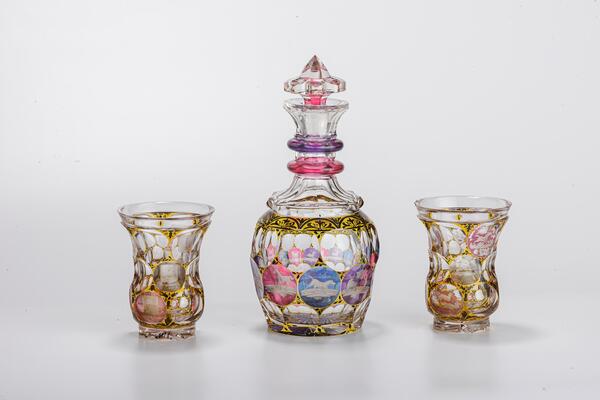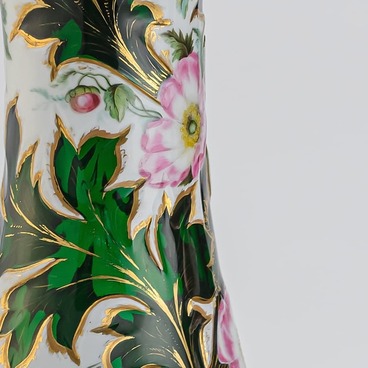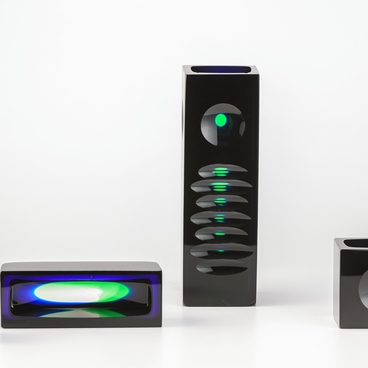The “Hunting” set from the museum’s collection includes two glasses and a decanter with a stopper made of thick-walled colorless glass. Cutting circular concave patterns, painting with luster paints and partial matte engraving were chosen for decoration. The combination of these techniques gives the impression of volume and completeness.
Under a thin layer of luster paints, the glass retains transparency and acquires a pure color and a characteristic metallic gloss. Matte engraving creates an effect of softness and restraint. The drawings are reflected in free lenses in such a way that the entire surface of the product seems to be covered with images of the same size. In accordance with its name, the decanter and one of the glasses are decorated with figures of deer, horses and hunting dogs. On the second glass, the artisan depicted the coats of arms of cities and dates.
The dates mark the milestones of the journey of the future Emperor Alexander II, Tsarevich Alexander, which he made from May 2 to December 10, 1837. The heir to the Russian crown visited 29 governorates, as well as the North Caucasus, Transcaucasia, Western Siberia, and Crimea with the aim of “getting to know Russia as much as possible and letting himself be seen by future subjects.” According to the memoirs, the journey was reminiscent of the return of a triumphant: everywhere a train of many carriages was welcomed by cannons firing and other celebrations being arranged.
The dates on the glass can be used to trace his route: Kazan on June 20, 21 and 22; Simbirsk June 23 and 24; Saratov June 27, 28 and 29; Penza June 30 and July 1; Tambov July 3 and 4; Voronezh July 6, 7 and 8; Tula on July 9 and 10; Kaluga on July 11 and 12; Smolensk July 14, 15 and 16.
Vasily Andreyevich Zhukovsky, who accompanied the heir, described their stay in Penza in his diary:
Under a thin layer of luster paints, the glass retains transparency and acquires a pure color and a characteristic metallic gloss. Matte engraving creates an effect of softness and restraint. The drawings are reflected in free lenses in such a way that the entire surface of the product seems to be covered with images of the same size. In accordance with its name, the decanter and one of the glasses are decorated with figures of deer, horses and hunting dogs. On the second glass, the artisan depicted the coats of arms of cities and dates.
The dates mark the milestones of the journey of the future Emperor Alexander II, Tsarevich Alexander, which he made from May 2 to December 10, 1837. The heir to the Russian crown visited 29 governorates, as well as the North Caucasus, Transcaucasia, Western Siberia, and Crimea with the aim of “getting to know Russia as much as possible and letting himself be seen by future subjects.” According to the memoirs, the journey was reminiscent of the return of a triumphant: everywhere a train of many carriages was welcomed by cannons firing and other celebrations being arranged.
The dates on the glass can be used to trace his route: Kazan on June 20, 21 and 22; Simbirsk June 23 and 24; Saratov June 27, 28 and 29; Penza June 30 and July 1; Tambov July 3 and 4; Voronezh July 6, 7 and 8; Tula on July 9 and 10; Kaluga on July 11 and 12; Smolensk July 14, 15 and 16.
Vasily Andreyevich Zhukovsky, who accompanied the heir, described their stay in Penza in his diary:





